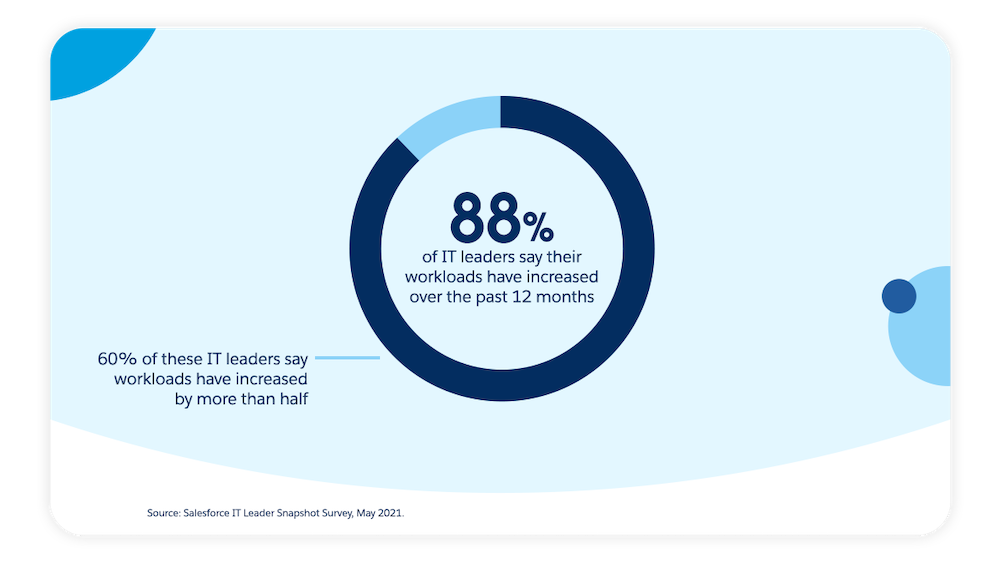Quick Take: New survey data shows that IT teams are increasingly overwhelmed by in-house demands. As a generation of digital natives from non-technical backgrounds becomes accustomed to low-code tools, however, IT leaders are warming up to the idea of allowing them to become the creators of new apps and experiences. The result could usher in a new era of innovation, speed, and collaboration in application development.
Salesforce has long believed that tapping into the power of designers, business analysts, and other business users is a key step toward breaking the growing logjam of IT backlogs. The rise of low-code development — represented by drag and drop tools, pre-packaged code, and reusable components — is now making it possible. With these tools, a wide diversity of creators can build the apps and experiences they need to do their jobs, and meet customer expectations.
To better understand this landscape, Salesforce surveyed IT leaders in the United States with responsibility for application development to gauge how the pandemic has impacted demand for new apps and experiences. Salesforce also sought to find out whether these IT leaders viewed low-code development tools — and critically, their use by non-IT creators — as a solution to offset IT demand moving forward.
The pandemic upped the digital ante for businesses — and IT
Previous research of consumers and business buyers found that expectations for digital experiences soared as end users migrated more and more of their personal and professional lives online during the pandemic. While the pace of digital change has increased since 2020, it also represents a trend that has been in process for years.
IT leaders are seeing the ramifications of these trends in both the demand for and impact of their work.
“The world has become ever more connected and, as a result, technology now plays a significantly bigger role in our lives and work,” noted Casey Coleman, SVP of Global Government Solutions, Salesforce in a recent interview. “That’s been a steadily advancing trend, but COVID-19 was a major inflection point that has made it clear companies need a digital strategy and a plan to quickly implement it.”
Increased workloads and a developer shortage are conspiring to curb innovation
While IT’s continued transformation to being a strategic and critical business partner is cause for celebration, it’s not without its pain points. The vast majority of IT leaders note increased workloads over the past twelve months, and those increases have been substantial.
70% of IT leaders are concerned that these increased workloads will curb their ability to innovate, given the everyday demands of “keeping the lights on.” Yet hiring more developers is easier said than done as job openings far outpace the number of computer science graduates.
Low-code tools and new partnerships with business units may be the path forward
Low-code development is increasingly popular as IT leaders seek to scale their capacity to meet soaring demand. In fact, 83% of IT leaders plan to increase their use of low-code app development tools.
The reality is that these low-code tools have already permeated consumer’s everyday lives, as well. When someone uses editing tools on TikTok or Instagram to customize a video, for instance, they’re using low-code tools. Similarly, low-code tools are used when configuring a smart home system to personalized needs and preferences.
With this new generation of digital natives so used to low-code interfaces in their own lives, it’s no surprise that they could use them in work settings — even without a formal, technical background.
A recent study found that application development by business users is still nascent. But IT leaders see change on the horizon — a massive opportunity for non-IT creators to come together with developers to co-create experiences.
IT leaders see several benefits from the use of low-code application development tools by this untapped crop of creators. For example, 91% believe such an approach would bridge business requirements with technical execution, 89% believe it would allow IT staff to focus on more complex initiatives, and 82% believe it would reduce IT’s project backlog.
More information
Simply throwing tools over the fence to creators and giving them permission to build apps is no recipe for success. IT needs the right tools and capabilities to ensure governance, security, and scale.
Tune in to TrailheaDX on June 23 at 8:45 a.m. PT to learn how Salesforce is empowering developers and creators to build trusted experiences as the future of application development shifts to low code.
Survey Methodology
Salesforce conducted a double-blind online survey of information technology decision makers (manager and above in seniority) with responsibility for application development in the United States. Data was collected between May 21 and May 26, 2021 and yielded 100 responses.





















